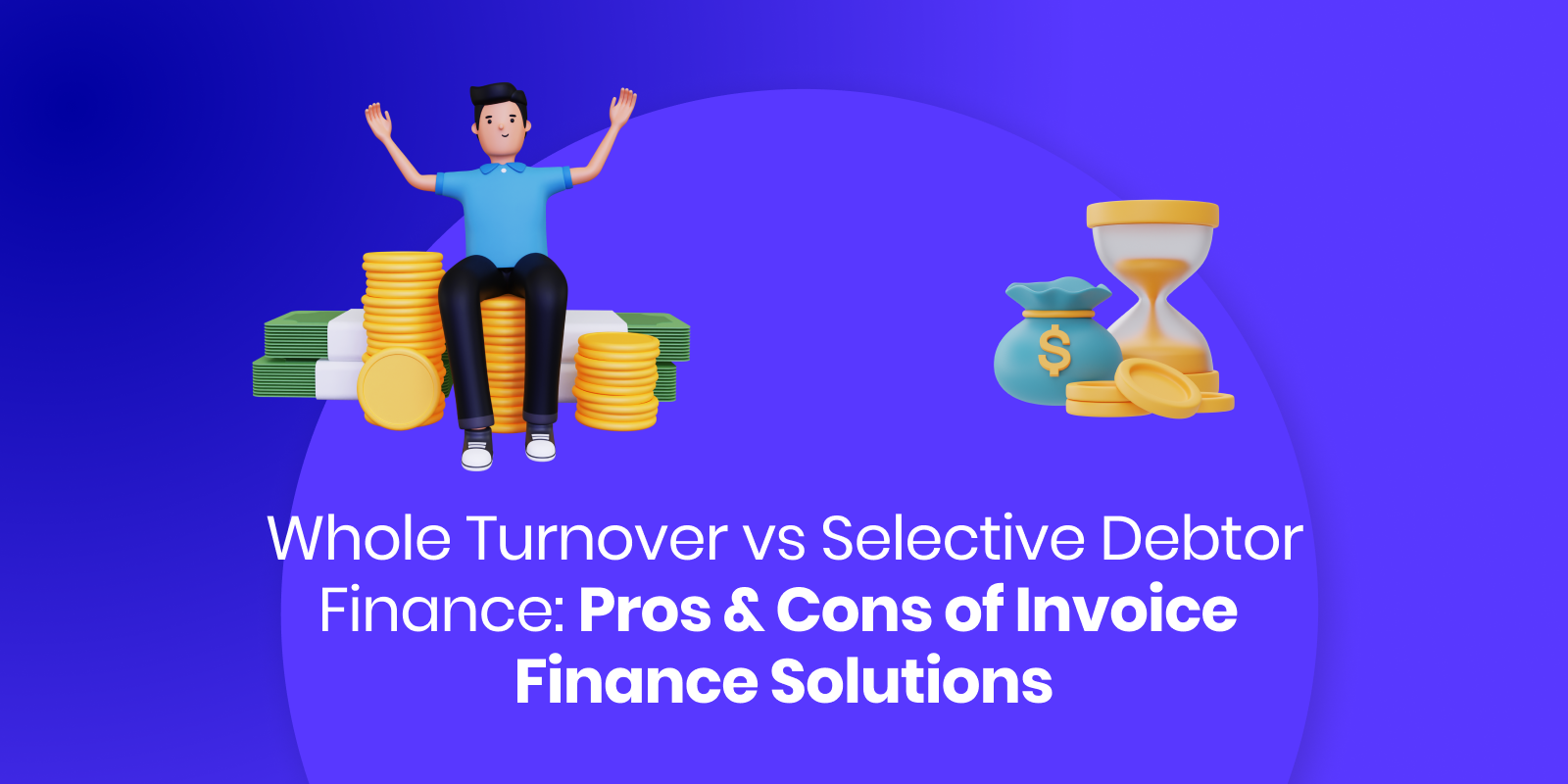Whole Turnover vs Selective Invoice Financing: Pros & Cons of Invoice Financing Solutions

It’s well known that invoice financing as an instrument can be an extremely powerful way to improve cashflow, by leveraging one of your company’s key assets – the invoices it generates. However, there are a number of invoice financing solutions available, including ‘whole turnover’ as well as selective invoice financing.
In this article, we explore the differences between these two invoice financing methods, and which one might be worth considering for your business. It must be stated though that when considering the product that might be right for you, it’s always worth taking advice from your accountant and talking to a reputable broker who can discuss the options available to you, before making your decision.
Whole Turnover Agreements
A whole turnover agreement is a credit facility that’s based on the turnover of your company. In practice, what this means is that each present and future invoice is effectively owned by the credit provider. When you raise invoices to your customer, you send them to the credit provider who will pay between 75% to 90% on receipt, and the balance when the debtor pays them.
The providers of whole turnover agreements will charge fees in two ways; the subscription for having the facility (usually billed monthly) and the fee for each invoice funded. The subscription tends to be fixed, based on the size of the facility offered, and the individual fees are based on debtor performance. In other words, the longer it takes your debtor to pay that invoice, the more expensive its funding is.
There are a number of things to consider in a whole turnover agreement, some of which we’ve outlined below.
1. Limited Access to Capital
In principle, the amount of credit available to you will be set at the beginning of the agreement, but the actual amount of credit available on a day-by-day basis depends on your debtors. Funds are available to be drawn only when a) you raise invoices and b) your debtors pay those invoices.
Imagine you have a £500,000 facility but you have £350,000 of invoices that have been funded but have yet to be paid by your creditors. The maximum amount available will be £150,000. When a debtor pays an invoice valued at, say, £15,000 this will increase to £165,000.
However, if you have a run of poor debtor behaviour, or you start to accelerate your business growth, you may find the actual funds available to you might be far lower than you think. Also, any credit availability will be net of costs.
2. Monetary and Time Costs
There are a lot of costs associated with a whole turnover agreement, in terms of both money and time.
The financial costs are significant. There will be arrangement fees to pay, a monthly subscription once the facility is up and running, and then charges on a per-invoice basis. Whilst these elements may seem manageable in isolation, it’s important to take a moment to add them up and model the true cost of the facility.
Then there are also costs in time. Time to apply for the facility, negotiate it, and time to manage it. These are complex facilities which require a degree of expertise on your part; from figuring out whether or not it’s right for your business at the front end, to its daily operational management, which can be time intensive if you don’t have the know-how to streamline it. To avoid unnecessary time and cost usage, take advice from your accountant and brokers to make sure that this invoice finance solution makes sense for you, your budget and your capacity.
3. Variable Complexity
By now, we’re probably stating the obvious, but these are complex facilities with a lot of variables to consider. They can make a great deal of sense for certain companies, particularly those that are larger and have a finance function in place with some understanding and experience of working with whole turnover agreements. Whatever you do, always remember that agreements tend to last for years, not weeks, so you have to be sure you are securing the right agreement for your company when you do take the plunge and commit to this kind of invoice finance solution.

Selective Invoice Financing
If whole turnover agreements are oil tankers, selective invoice financing is a speedboat! Designed to be flexible and easy to understand, it’s a compelling invoice finance solution, particularly for those companies that haven’t considered invoice finance in the past, and may not have the expertise in-house to manage more complex facilities. At Hydr, we have pioneered selective invoice financing, and we passionately believe it’s the best possible invoice financing solution for small companies. Below we discuss a few of the reasons why.
1. Easy Access to Capital
Selective invoice financing means just that; you select which customers on your balance sheet you would like to be funded. From that point onwards, all invoices present and future are taken on by the invoice financing solution provider. You might generate one invoice one month, and then the next month: as long as they are all credible invoices, they will be funded with ease.
2. Transparent Costs
The purest form of selective invoice financing is that you are charged strictly on a per-invoice basis. This is what we do at Hydr – we fund 100% of the value of each invoice generated minus our fixed fee. We do not charge a subscription for having an account on our platform, nor do we charge any arrangement fees. Even if your debtor is a little behind in making payment, the fee remains fixed, always.
3. Reduced Complexity
Selective invoice financing is a simple concept to understand; certain debtors pay you directly, while others are funded through a third party. When you raise an invoice for one of those being funded, you receive the funds within 24 hours. When you raise invoices for those debtors not being funded, they will be paid to you directly, hopefully within the agreed-upon payment terms.
The art of using a selective invoice financing product well is choosing which debtors should be funded. Ideally, getting the cash for those invoices within 24 hours will mean that you simply do not need to have to consider another form of funding or borrowing. And, with class-leading digital experiences offered by modern invoice financing solutions providers, like Hydr, managing day-to-day finance is paperless, transparent and straightforward.
Summary: How Hydr streamlines selective invoice financing
There are many invoice financing solutions out there, and one size doesn’t fit all.
For the right invoice financing solution, take your time to research the options available to you, and consider their cost, complexity, and if their available facilities meet your needs.
Compared to whole turnover invoice financing, selective invoice financing gives you more control, with less complexity, letting you enjoy the benefits of invoice finance without sacrificing your time or budget. Invoice finance should empower your cash flow, not complicate it, that’s why we’ve made invoice financing as easy and accessible as possible. Contact our friendly team to learn more about Hydr’s invoice financing solutions.

